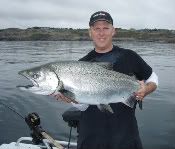In poking around with some articles on the PS orcas I found that of the three resident pods of orcas found regularly here in PS (J, K, & L) only on them have shown a volatility in abundance with a recent decline and accounts for the decline in the aggregate abundance.
That is the L pod and of the 3 it seems to be the one that ranges the fartherest (members seen off Calofornia) and seems to the one that spend the least time in Puget Sound. The J pod which reportedly is the most "resident" pod (at least in the San Juans) numbers over the last 30 years has been stable or slowly increasing. From listening to the ongoing debate about "our" orcas not what I expected to find.
One diet study found at this time of the year their diet shifted so that the most commonly eaten salmon were chum. As speculated by others probably not a surprise.
Tight lines
Curt
I was wondering if while poking around one of the articles you found was the Shannon McCluskey 2006 UW thesis (can be downloaded from NOAA Northwest Science Center orca recovery site). It points out what you stated and a lot more in it's 134 pages. One of the interesting conjectures I saw in a quick skim of the text relates to this discussion. Besides the usual reasons that chinook are preferred, high fat content and large size, is that chinook are available year around and travel near to shore. There is some speculation that over time the orcas that specialize on chinook have learned to herd them using underwater topography as barriers to their escape. The west side of San Juan Island does have underwater topography that would facilitate that kind of behavior and chinook from the Fraser and Puget Sound are available year around. I have wondered why the orcas are present in that area for such a large part of the year. It may be that the underwater topography aspect of their feeding behavior is as important as what they eat. It may not be that they will only eat chinook, obviously they go for chum, especially in the south sound, it is more likely the hunting technique determines what they eat.
The thesis has a wealth of info about orcas and a surprising amount of information about salmon runs. The chapter introduction and discussions are worth reading if you have an interest in the relationship between salmon and orcas.















 Previous Topic
Previous Topic Index
Index

